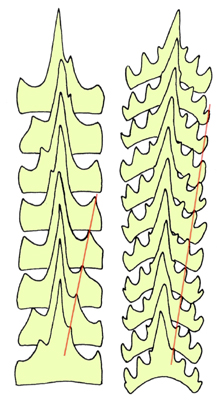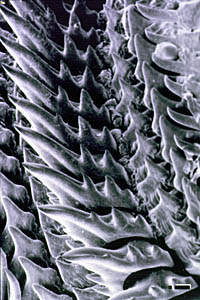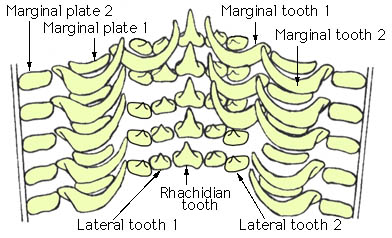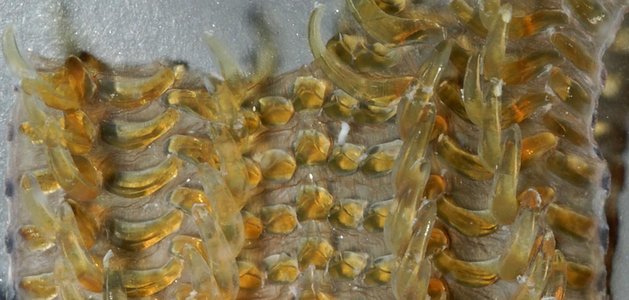The radula of neocoleoid cephalopods consists of a maximum of nine elements. The terminology is shown here for the two basic types of decapodiform radulas, the heterodont radula with more than one cusp on the rhachidian tooth and, usually, the first lateral teeth and the homodont radula with a single cusp on all teeth. Many modifications to the basic pattern exist. One of the most peculiar is the "ctenoglossan" radula of bolitaenid octopods in which all lateral teeth are multicuspid.


Figure. Left: Thysanoteuthis rhombus, modified from Naef, 1923. Right: Sepia orbignyana, modified from Naef, 1923.
Many octopods have a peculiar type of heterodont radula in which the cusps of rhachidian tooth vary from one tooth to the next in a sequential manner. This arrangement is called seriation and results in a serial repetition along the radula. The number of teeth representing a series varies with the species but commonly the fifth tooth will resemble the first (see illustration on the left). The seriation can involve either asymmetrical (left drawing) or symmetrical (right drawing and the scanning electron micrograph) rhachidian teeth.



Figure. Rachidian teeth. Left - Octopus vulgaris. Drawing modified from Nixon, 1995. Middle - Octopus macropus. Drawing modifed from Nixon (1995). Right - Octopus sp. Scanning electron micrograph by Mark Norman.
The radulas of Nautilus spp. are more complex than in the members of the Neocoleoidea. A total of 13 elements is present. The illustration on the right has attempted to clarify the arrangement by the elimination of the first marginal tooth from a number of the rows.


Figure. Radula of Nautilus pompilius. Drawing modified from Naef (1923).


Figure. View of a portion of the radula of Nautilus sp.. Compare with drawing above. Photograph by R. Young.




 Go to quick links
Go to quick search
Go to navigation for this section of the ToL site
Go to detailed links for the ToL site
Go to quick links
Go to quick search
Go to navigation for this section of the ToL site
Go to detailed links for the ToL site